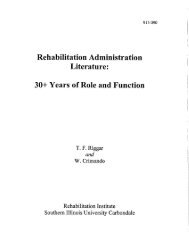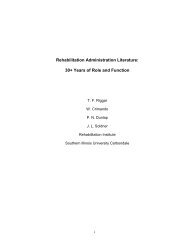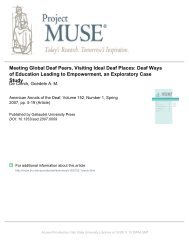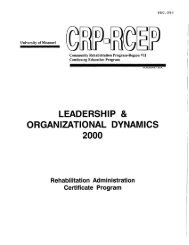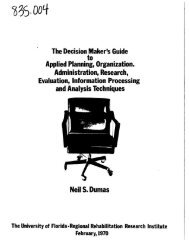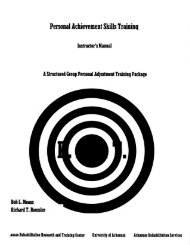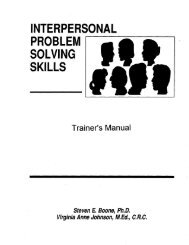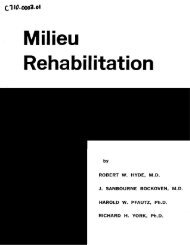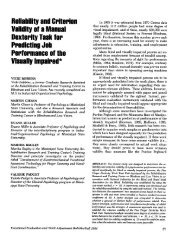by requirements for the degree of (Education) - NCRTM
by requirements for the degree of (Education) - NCRTM
by requirements for the degree of (Education) - NCRTM
Create successful ePaper yourself
Turn your PDF publications into a flip-book with our unique Google optimized e-Paper software.
1966-67 to 20% (51) in 1968-69 (Table XVII). This is somewhat disturbing<br />
since <strong>the</strong> poverty indicator <strong>for</strong> a single person as determined <strong>by</strong> <strong>the</strong> U. S.<br />
Department <strong>of</strong> Labor (U. S. Department <strong>of</strong> Labor, 1969) is a net amount <strong>of</strong><br />
$1600 per year ($30.77) per week. The majority <strong>of</strong> individuals closed as<br />
competitively employed received gross earnings between $51 and $75 per<br />
week at <strong>the</strong> time <strong>of</strong> closure; this varied from 42% (66) <strong>of</strong> <strong>the</strong> total number<br />
closed in 1966-67 to 61% (153) in 1968-69. Table xviI also shows that <strong>of</strong><br />
<strong>the</strong> 659 people closed as competitively employed over <strong>the</strong> three year period,<br />
76% (503), were identified as mildly retarded, 22% (144) as moderately re-<br />
tarded and two per cent (12) as severely retarded. There was little dif-<br />
ference between <strong>the</strong> mildly and moderately retarded in <strong>the</strong> percentage <strong>of</strong><br />
people grouped in <strong>the</strong> various gross weekly earnings categories. The<br />
earnings <strong>of</strong> <strong>the</strong> severely retarded tended to be low.<br />
Of <strong>the</strong> 159 individuals closed in non-competitive employment during<br />
<strong>the</strong> three years studied, 38% (61) were unpaid family workers, 35%<br />
were sheltered workshop employees and 27% (43) were homemakers (Table<br />
XVIII). The gross weekly earnings at time <strong>of</strong> closure <strong>for</strong> 92% (145) <strong>of</strong><br />
<strong>the</strong>se clients was $25 or less; <strong>of</strong> this number 64% (i01) received no weekly<br />
earnings because <strong>the</strong>y were functioning as homemakers or unpaid family<br />
workers. Seventy-six per cent (42 clients) <strong>of</strong> <strong>the</strong> sheltered workshop em-<br />
ployees earned $25 or less per week. Of <strong>the</strong> non-competitively employed<br />
58% (92) were identified as mildly retarded, 34% (54) as moderately re-<br />
tarded, and eight per cent (13) as severely retarded.<br />
A comparison <strong>of</strong> competitive and non-competitive closures shows that<br />
84% <strong>of</strong> <strong>the</strong> mildly retarded, closed rehabilitated, were competitively em-<br />
ployed; <strong>the</strong> percentages <strong>of</strong> <strong>the</strong> moderately and severely retarded placed<br />
in competitive employment were 73% and 48% respectively.<br />
53




